If you have a toddler gearing up for potty training, you’re probably in the pull-ups vs diapers dilemma.
As a mom with three kids under the age of 5, I’ve been there. I mean, I am there!
So, in this article, I’m diving into the nitty-gritty of pull-ups vs. diapers and laying out all the pros and cons.

What Are Pull-Ups?
Pull-ups, sometimes called training pants, are a hybrid between standard diapers and those cute little toddler undies.

They’re designed to give your little one a taste of independence in their potty-training journey.
Different brands call them different things; Pampers calls them Easy Ups, Huggies pull ups are simply called Pull-Ups, and Coterie calls theirs The Pant (very fancy!).

No matter which brand you buy from, they all have stretchy sides, mimic undies, and are meant to allow little hands to pull them up and down.
Unlike diapers, pull-ups have a looser fit, which gives your little explorer a bit more freedom to move around.
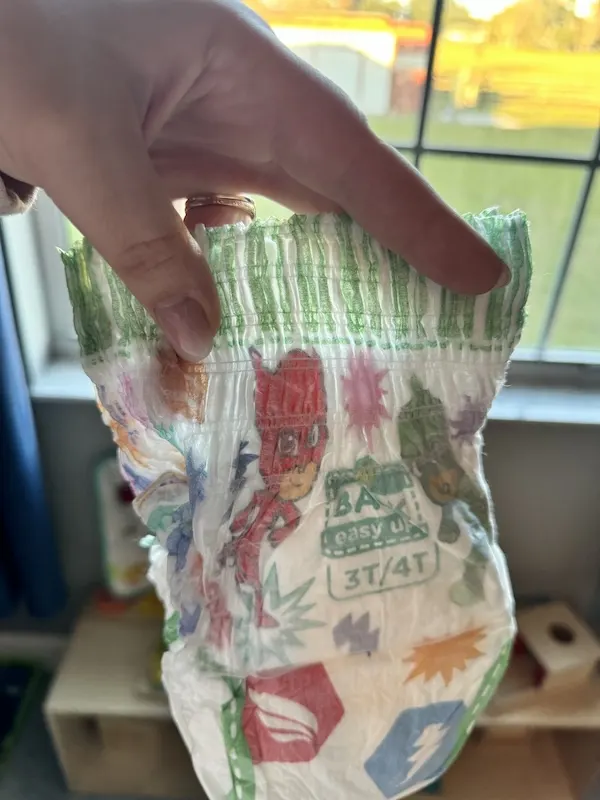
Your child can step into them and pull them up just like regular underwear, which gives them a bit of independence. It can also help with the transition out of diapers when they’re ready to potty train. It’s funny how all the milestones start to connect. First potty training, then sitting at the table like a “big kid” and suddenly they’re insisting on doing everything themselves!
Unlike regular underwear, pull-ups are disposable training pants, so when they get soiled, you do need to toss them.
Hybrid Diaper/Pull-Up
It’s worth mentioning that some brands have somewhat of a hybrid between diapers and pull-ups, like Huggies Slip-On Diapers and the Pampers Cruisers 360 Diapers.
They are made to be just as absorbent as diapers, but they pull up instead and tear off for removal.
They claim to make either stand-up or lie-down diaper changes easy with the tear-off sides, but the verdict is still out on that one.
This could be a great option in case you find the tabs of regular diapers annoying or cumbersome for your baby but aren’t quite ready for toilet training.
Overnight Diapers
Overnight diapers are another variation, but they’re basically just diapers designed to contain even more wetness. If your baby wakes up every morning super wet, overnight diapers could be something to try.
In my experience, sizing up your regular can do the trick, though. Overnight diapers are pretty expensive, so it’s worth trying the next size up before investing in them!
We’ve also had amazing success with Coterie diapers, and this is coming from a mom who has cheaped out with Luv’s for many years.
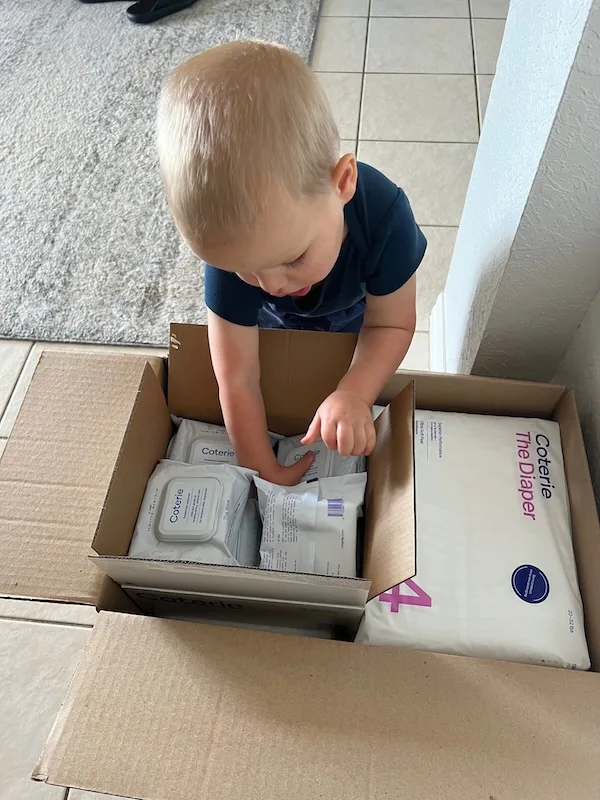
Coterie diapers have a super absorbent core, meaning fewer diaper changes are required. We’ve never had a blowout with Coterie.
Related: 12 Life-Saving Tips for Preventing Diaper Blowouts Up the Back
When to Use Pull-Ups vs. Diapers
Parenting is all about perfect timing… or at least trying to get close.
Most moms make the switch to pull-ups at the start of potty training, but that age can vary quite a bit.
Most families start potty training around age 2 or 3.
However, I’ve seen mothers potty train their literal infant, and I’ve also seen mothers struggling with potty training at age 4.
Many moms following Montessori potty learning techniques start training around 12 months of age.
At the end of the day, your best indication that your child is ready for potty training is by looking for signs of readiness.
Potty Training Signs of Readiness
Signs of readiness include:
- Asking/showing an interest in using the potty
- Putting on/taking off clothes
- Following simple potty-related instructions
- Staying dry for 2-hour periods/waking up from naps dry
- Telling you when they have a dirty diaper
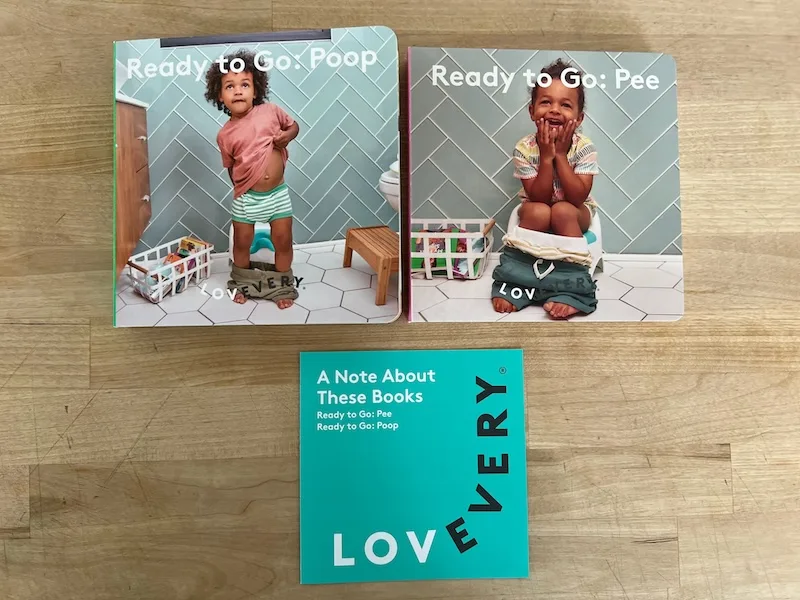
Every child is different, and you don’t want to rush it or pressure them into it. Pushing them into potty training before they’re ready will probably just end in frustration for both of you.
Also, keep in mind that there are many different ways to potty train and every family does it differently.
From Diapers to Training Underwear
Our family transitioned right from traditional diapers to training underwear – which is essentially just thicker underwear – as soon as our kids could go a full day without any accidents.
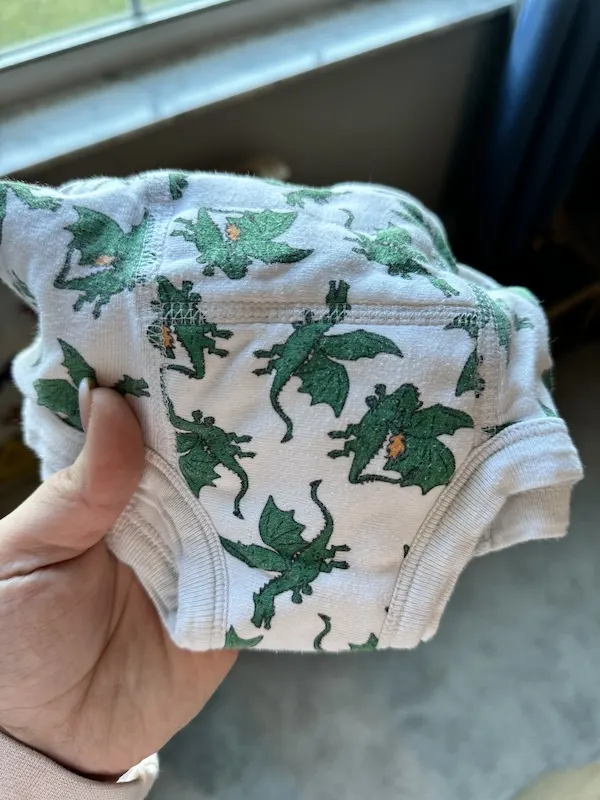
At night, we use pull-ups to prevent bedwetting since our kids are still 3 and 5. It gives me peace of mind that I won’t be starting my day with a huge mess, and it ensures our kiddos don’t feel like they’ve made a huge mistake.
In reality, bedwetting is a typical part of a child’s development at that age and doesn’t indicate any issues with potty training.
Since children typically don’t gain the ability to control the urge to go while sleeping until around age 7, I don’t plan on getting rid of the pull-ups just yet.
From Training Underwear to Big-Kid Underwear
Training underwear is pretty thick and is more absorbent than big-kid underwear. So as soon as your child has potty training downpat – we waited a good 6 months – you can move on up to regular, big-kid underwear.
Our son is almost 4 and we currently have a mix of training underwear and regular underwear. At this point, I won’t be purchasing any more training underwear as he has been accident-free for quite some time.
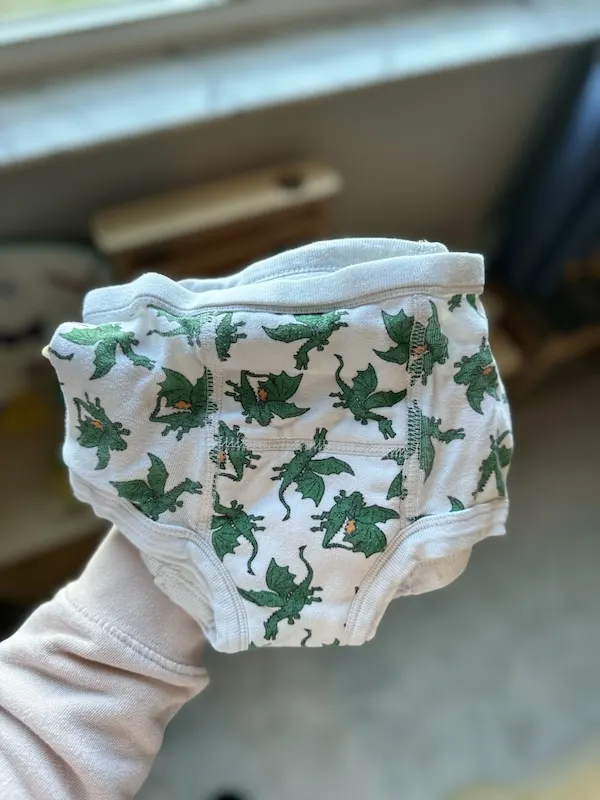
But again, it’s all up to what feels like the right choice for your kiddo. Mama knows best!
Pull-Ups vs Diapers: The Pros and Cons
Here’s a list of pros and cons for diapers and pull-ups to help you decide when to switch.
Regular disposable diapers
| Pros | Cons |
|---|---|
| Convenient for quick changes | Contributes to waste |
| Available in a variety of different sizes | Doesn’t promote independence |
| Generally more affordable | Abrupt transition to underwear |
| Provides a snug fit | Can be bulkier |
| Most have wetness indicators | Less breathable |
Pull-ups
| Pros | Cons |
|---|---|
| Mimics underwear, easy to pull on/off | Contributes to waste |
| Encourages independence in potty training | Fewer sizes available – starts at 2T |
| Closer to underwear feel, less bulk | May delay the transition to underwear |
| Can be useful in avoiding nighttime bedwetting | Cost slightly more than diapers |
| Tend to have more fun designs | No wetness indicator |
| More breathable |
Honestly, the main difference between diapers and pull-ups is how they’re put on. The diapers have side tabs, while pull-ups have a stretchy waistband that you, well, pull up.
I’ll also mention the product description of most pull-ups will tell you they’re more breathable, which can make them a lot more comfortable for young toddlers.
Are Pull-Ups Better Than Diapers?
The big question is: Are pull-ups a better option than diapers, particularly when you’re starting the potty training journey?
Let’s break down the different variables.
Convenience
From a parent’s standpoint, both diapers and pull-ups are convenient for on-the-go changes. They’re disposable, and you can throw them in your backpack on the way out the door.
If you’re still the one doing the changing, the refastenable tabs on diapers allow you to open them and pull them off without making a mess.
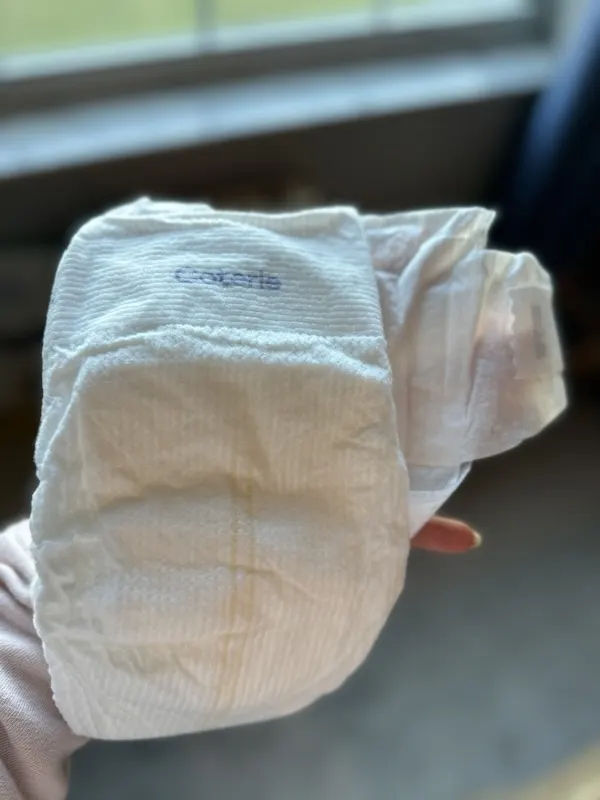
But when you’re in the potty training days, and you’ve got a toddler who’s in DIY mode, I think pull-ups might have the upper hand in terms of convenience.
Your child can pull them up and down without wrestling with tabs or folding making them the hassle-free choice for the “I can do it myself” spirit.
Comfort
Diapers are bulkier and might not be the comfiest option for little ones who are constantly on the move.
Those adorable wobbly steps or toddler sprints don’t exactly scream comfort with a diaper’s added heft during these adventures.
With certain brands, the tabs can be annoying and scratchy. For any parent who’s dealt with those tiny red marks on their child’s tender skin, the discomfort from diaper tabs is all too real.
One of the key advantages of pull-ups are the more streamlined fit, tackling the bulkiness issue and offering a closer-to-underwear feel.
This shift can be a game-changer for our toddler explorers, granting them a broader range of motion without the encumbrance of excess material.
Absorbency
Leaks can be a mom’s worst nightmare. But are pull-ups as absorbent as diapers?
Many people claim that pull-ups are slightly less absorbent than diapers, but in my experience, I’ve found that pull-ups and diapers are almost equally absorbent.
The key for me has always been about getting the right fit, be it diapers or pull-ups, to avoid blow-outs and leaks.
If they’re too big, everything will just come right out the side, and if they’re too small, not only will they be uncomfortable, but they will overfill quicker, too.
Related: How to Get Rid of a Diaper Rash In 24 Hours (It’s Magic!)
Age-Range and Sizing
While the average age for starting potty training in the US is on the rise, some parents are kick-starting the process much earlier.
Some even dive into potty training from birth with elimination communication – although that’s a whole different ball game that doesn’t involve diapers or pull-ups, and it’s not something I ever got into.
Still, in terms the range of sizes, pull-ups would be more suitable for slightly older toddlers who are in the process of potty training, while diapers can be used from birth to the young toddler years.

Most pull-ups start at size 2T, but the weight range is pretty big (depending on the brand, between 16-34lbs). This flexibility means they can work for smaller toddlers if you’re eager to kickstart potty training early.
Diapers, on the other hand, range from size newborn to size 7.
Price Difference
Cost-wise, pull-ups may be slightly more expensive than diapers, depending on the brand, but they might be worth the investment for the added convenience and ease of use during the potty training phase.
Plus, they may end up saving you money in the long run if they help speed up the potty training process and get your kids out of disposables altogether.
To give you an idea, a 76-pack of Huggies diapers at Target costs approximately $28.50, and a 74-pack of Pull-Ups (also made by Huggies) would cost $30.50. So you get a couple less for a couple of dollars more, but nothing that will break the bank.

In the end, it’s all about finding the right balance between what will suit your family best at the moment and the cost, so you can keep your little one dry and comfortable without breaking the bank.
Pull-Ups vs Diapers: The Verdict
Ultimately, the choice of pull-ups vs diapers depends on your child’s age, level of activity, and readiness for potty training.
For us, pull-ups were definitely worth transitioning into when we started potty training, and we still use them at nighttime, well after our kids were fully trained.
It’s all about finding the right choice for both you and your little one.

More Articles to Check Out Next:
Yasmin is a writer and mother of two young children. She is also the woman behind Two Mama Bears, a blog for parents with babies and toddlers.

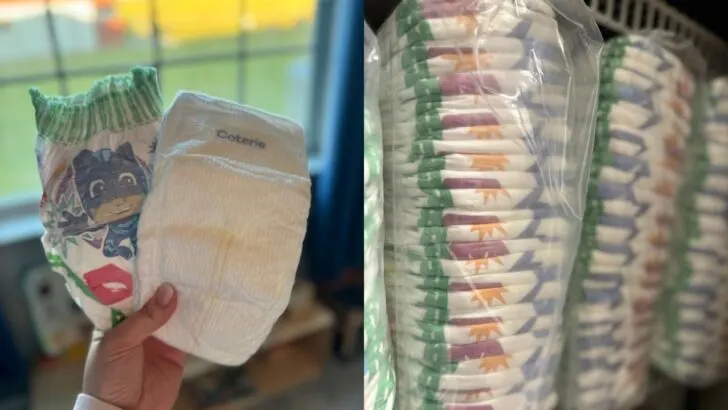
Lauren
Monday 23rd of June 2025
This is such a massive help... thank you!!!
I'm the mom of two boys-- but struggling with figuring out when/how to potty trained my youngest...simply because my oldest son basically trained himself, in a single weekend out of the blue!
So even though we're on kid #2, I've basically never had to experience potty training before... and my youngest is looking like he's going to be *WAY* more of a challenge on that front than his brother was!
Here's a dumb question. For a kid that's 100% totally trained in the daytime, is there a benefit to using pull-ups at night, vs just a larger sized diaper..?
My oldest sleeps like a ROCK, and still wets the bed on occasion. When he's staying at his grandmas house though, she's always just preferred to put a larger size diaper on him for bedtime (we mostly use pull-ups at home).
I try and respect her preferring that, since she's being a huge help watching the kids while I'm at work. But, wasn't sure-- does it matter, diaper vs. a pull-up at night..? For an older kiddo..?
Yasmin
Sunday 7th of September 2025
Thank you so much for your kind words! 💕 Honestly, you’re not alone—nighttime potty stuff can be a whole different ballgame. Diapers tend to hold more, which is why a lot of grandparents stick with them for heavy sleepers, while pull-ups are nice if kids wake up and want to try the bathroom on their own. At the end of the day, it really doesn’t matter—using diapers at grandma’s and pull-ups at home is totally fine and won’t mess with progress.